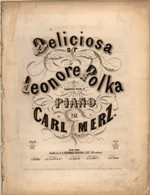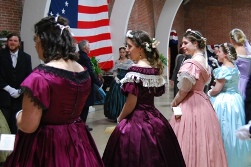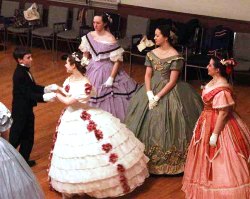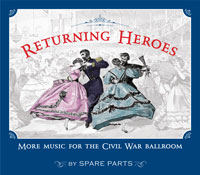 The Ball Card:
(over 64 minutes of music)
The Ball Card:
(over 64 minutes of music)
1. Deliciosa, or Leonore Polka (1:51)
2. Grand March: Stephen Foster Medley (9:44)
3. La Redowa (2:20)
4. Zouave Schottische (2:32)
5. Jeff Davis's Dream: a jig medley (5:20) [9 x 32 bars]
6. La Douce Pensée Polka Mazurka (2:30)
7-11. The Rats Quadrilles, 5 figures
12. The Wrecker's Daughter Galop (2:22)
13. Willie Mazurka (2:48)
14. Dodworth's Very Best Polka (2:16)
15. Single Quadrille medley: [4 x 32 bars with 8-bar intro]
Turkey in the Straw & Devil's Dream (2:38)
16. Polka Contra Medley (5:00) [8 x 32 bars]
17. La Cachucha, a waltz (3:14) [4 x 32 bars with 8-bar intro]
18. Virginia Reel: Southern Belles Medley (5:56)
19. Endearing Young Charms (3:49) [8 bars + 4 x 32 bars + 8 bars]
more about the music:
1. Deliciosa, or Leonore Polka [audio sample]
(Karl Merz, 1854, from The Welcome Guest, 1863)
Since the Grand March can't commence until most dancers have arrived at the ball,
a polka or waltz is often played as a prelude dance. This polka was composed for piano.
Our version is a simplified arrangement by A. Baumbach, composer of "Wearing of the Green."
Composer Karl Merz (1836-1890, sometimes spelled Carl Merz) moved to the U.S. from Germany in 1854.
He was a respected music professor who published popular books on piano, performance, and composition. This tune
also appears in The Home Circle Vol. I (1859) and Howe's Drawing Room Dances (as "Lenore" in a polka quadrille, 1859).
2. Grand March: Stephen Foster Medley [audio sample]
Oh! Susanna (1848; undated arrangement by S. Foster, courtesy of Lester Levy Collection)
Old Black Joe (1860; original sheet music, courtesy of Lester Levy Collection)
Massa's in de Cold Ground (1852, from Foster's Social Orchestra, 1854)
Hard Times, Come Again No More (1854; original sheet music, courtesy of Lester Levy Collection)
My Old Kentucky Home, Good Night (1853, from Foster's Social Orchestra, 1854)
Stephen Collins Foster (1826-1864, born on the Fourth of July on the 50th anniversary of the
Declaration of Independence) was America's favorite songwriter at the time of the Civil War.
"Oh! Susannah" was adopted instantly by the Forty-Niners; the other songs here spread just as quickly.
In addition to composing songs, Foster played the violin and flute and worked as an arranger.
Foster included some of his own songs in his collection, The Social Orchestra for Flute or Violin:
A Collection of Popular Melodies..., arrangements for people to play in their homes and for small gatherings.
3. La Redowa [audio sample]
(Friedrich Burgmüller, from The Welcome Guest, 1863)
The Redowa (or Redowa waltz) is a lively and exhilarating variation of the common waltz. If you can't
untangle the instructions below, you can dance an ordinary waltz to this music. Johann Friedrich Franz
Burgmüller (1806-1874) was a German-born pianist and composer who lived in Paris. The earliest version
of this music I found was in the December 1846 issue of Godey's Lady's Book. There it is described
as a "Valse Bohemienne" with these dance instructions:
The REDOWA WALTZ is composed of three steps: The 1st, a glissade forward in jumping with the right foot;
the 2d, a slide forward with left foot; and the 3d, to bring the right foot before the left. This step is
done alternately with the right foot and the left foot; but in starting with the left foot, to turn, it is
necessary to do but one glissade backward and two emboités to take again, afterward, with right foot.
This is the principal step of the REDOWA usually preceded by a PROMENADE and followed by a POURSUITE.
The promenade is done with the Allemande step, that is to say, a slide foreward and chassez. The POURSUITE
is composed of a slide, jetté and coupé. The gentleman pursues the lady, holding her as in the Waltz, the
lady executing the same step, but backward. For these three steps the lady must always start with the
counter foot, and if executed alternately each one must be done 16 bars, taking care that the other
couples all change step at the same time.
4. Zouave Schottische [audio sample]
(F.E. Garrett, published in
Peterson's Magazine, Sept. 1861, "by permission of Sep. Winner, proprietor of the copyright")
"Zouave" is the name adopted by a couple of battalions of elite Algerian French infantry in the 1830s.
The name comes from a Berber tribe in North Africa. A few Civil War regiments adopted their colorful
costume and flashy drills along with the name, including one regiment based in Salem, Mass.
Peterson's Magazine was a popular monthly published by Charles Peterson of Philadelphia;
by the 1870s it had the largest circulation of any ladies' magazine. Our thanks to Joan DeGusto
for loaning us the issue. The only other music by F.E. Garrett I was able to track down was "The Shoddy Ball: a comic song" (1863).
5. Jeff Davis's Dream: a jig medley
Steamboat Quickstep (Musician's Omnibus, 1861)
Rakes of Kildare (R.M. Levey's First Collection of the Dance Music of Ireland, 1858)
Jeff Davis's Dream (Bernard Covert, Boston: Henry Tolman & Co., 1862)
These jigs are suitable for any standard country dance or contra. Steamboat Quickstep is also
in Howe's Drawing Room Dances (1859) as "Washington or Steamboat Quickstep." It may sound familiar
to fans of Tchaikovsky's Nutcracker ballet; the melody is heard in Act 1 as part of the Children's Galop
and Entry of the Parents. Tchaikovsky's notes indicate he took the melody from a well-known French children's
song, Bon voyage Monsieur Dumollet (1809). Thanks to Jessica Schein for this bit of history.
I found "Jeff Davis's Dream" in Singing Soldiers: A History of the Civil War in Song by Louis C. Singer and Paul Glass.
Covert was a Civil War-era composer, better known for "Can I Go, Dearest Mother" (1862). His lyrics
allude to politicking by England and France. "Mudsill" is unflattering Southern slang for a Yankee or lowlife.
lyrics:
Jeff Davis awoke one morn from a dream,
A horrible dream, a horrible dream;
He jumped out of bed with a terrible scream,
A terrible scream gave he.
He dream'd that a mud-sill stood close by his bed,
In the garb of a Zouave in flannel red;
With a noose made of hemp, slipping over his head,
Saying come along traitor with me.
 Jeff Davis he stared, he trembled and shook;
Jeff Davis he stared, he trembled and shook;
He was mightily scared and by friends all forsook;
For a very long passage he knew he was booked,
He knew he was booked did he.
He stood all aghast, as he viewed a strange scrawl
It was the hand writing he had seen on the wall,
Predicting at once succession's downfall,
What a mighty great fall said he.
Dear Yancy, Cobb, Benjamin, Thompson and Floyd;
Your hearts are as pure as the gold unalloyed;
But I verily fear we shall all be destroyed,
And I'm greatly annoyed said he.
Of our villainous doings I know you won't peach;
For thirty long years secession we've preached,
And we never stole anything out of our reach,
Quite out of our reach said he.
Old England and France, their gold did advance,
For tobacco and cotton they wanted a chance,
To break the blockade they promised their aid,
They were not afraid not they.
But the Yankees by magic they sent down a fleet,
And closed all our rivers and harbors complete
And caused us too often to beat a retreat,
And suffer defeat, said he.

Our northern seccessioners made us believe
They'd be with us, fight with us, never deceive,
But their cowardly hearts have caused us to grieve,
Have caused us to grieve, said he.
Both England and France they now look askance
To aid us they've not even broken a lance
Those big bullies have left us on nothing to dance.
On nothing to dance, said he.
Ye fools of ambition take heed of my fate;
Once proud my position of power and estate;
Had I remained loyal, I might still have been great
I deserve the world's hate, said he;
My countrymen all, take warning by me;
Stand by the old flag and true liberty
Prosperous, glorious and honored, you'll be,
In spite of the world, said he.
6. La Douce Pensée Polka Mazurka
(Charles d'Albert, from The Welcome Guest, 1863)
A polka mazurka is a turning dance with small leaps, somewhere between a polka and a waltz.
It's possible to dance an ordinary waltz to this music, as it is in ¾ time. Like Dodworth, D'Albert (1809-1886) was both a dancing master and a popular composer.
The Welcome Guest includes several of his dance compositions, as does this recording.
"Douce Pensée" appears as "Sweet Thought" in The Home Circle Vol. II (1863).
7-11. The Rats Quadrilles
(G. Redler, Philadelphia: J.E.Gould, n.d. [1852?])
7. No. 1 - Le Pantalon (ABAC x 4 + A) [audio sample]
8. No. 2 - L'Été (ABB x 4 + A)
9. No. 3 - La Poule (ABAC x 4 + A)
10. No. 4 - La Pastourelle (ABCB x 4 + A)
11. No. 5 - Finale (AABB x 4 + AA) [audio sample]
This popular quadrille set was composed for the student dancers (les petits rats, or the little rats)
of the Paris Opera Ballet, according to Barbara Pugliese. Even today, the students of the Paris Opera
Ballet School and some other ballet companies are sometimes called les petits rats. The quadrille is
listed in the 1852 Catalogue of Music published by Cramer, Beale & Co. of London. It appeared
in many editions in many countries in the late 1850s; some editions list the composer as J. Redler.
The Rats Quadrilles also appear in popular collections such as Musician's Omnibus (1861) and
Party Dances (1870). The melodies of Redler's 1853 composition "Les Chats Quadrilles" aren't
nearly as charming, though the cover states it is a "companion to Les Rats."
12. The Wrecker's Daughter Galop
(J.G. Von Rieff, 1840)
This lively tune works well for a galop, though the cover says "A quick step as played by the Boston Bands."
The many sheet music editions demonstrate its popularity, as does its appearance in The Star Collection
(1858), Howe's School for the Violin (1851), and The Welcome Guest (1863). Most sources
list J.G. Von Rieff as the composer; a few (including some 1840 editions) credit Conrad Fay.
13. Willie Mazurka
(James Bellak, 1857)
The mazurka is a lively dance, well suited to the young people who made up most of the crowd on the
mid-nineteenth-century dance floor. Since the music is in ¾, you can also waltz to this music. Our
thanks to Eric Stott, who gave us the sheet music.
14. Dodworth's Very Best Polka
(Allen Dodworth, New York: William Hall & Son, 1850)
At the top of the original sheet music, "dedicated to the 'Tip Top'" (whoever they may be) follows "The Very Best."
We dropped a few repeats, to match William Dressler's 1851 arrangement. The same year this polka came out (1850),
a different publisher produced "The Very Worst Polka," with similarly slanting type on the cover, by the composer
"Schlechter Als Schlecht." Those German words translate as "worse than bad." Multi-talented Allen Dodworth (1817-1896)
started out in his father's New York band as an accomplished piccolo player. He went on to become the band leader,
then a respected dance master as well as a composer. An entire issue of the journal Dance Index
(Vol II, #4, April 1943) is devoted to Allen Dodworth. In that journal historian John Martin notes, "it is safe
to say that no other figure in nineteenth-century America made a greater contribution to the dance than Allen
Dodworth." Dodworth's wife Cally helped manage his dancing school; his "Cally Polka" is one of the dances
on our Civil War Ballroom CD.
15. Single Quadrille medley [audio sample]
Turkey in the Straw (Howe's Drawing Room Dances, 1859)
Devil's Dream (Howe's Drawing Room Dances, 1859)
Suitable for any single quadrille figure such as The Cheat, this medley is the standard 32 bars played 4 times through,
with an 8-bar introduction. Turkey in the Straw, first known as Zip Coon, was published by Elias Howe
in his Ethiopian Glee Book of minstrel songs in 1849. (Gumbo Chaff, sometimes listed as author,
is an alias for Elias Howe.) Devil's Dream dates back to about 1790 in Scotland, where it is known as
De'il Among the Tailors. Both classic fiddle tunes appear in many midcentury sources. Ruthie is playing
twin fiddles here.
16. Polka Contra Medley
King Pippin Polka (Charles d'Albert, n.d., from The Welcome Guest, 1863). Also appears in The Home Circle Vol. II (1863)
First Love (Downing, n.d., from Howe's One Thousand Jigs and Reels, ca. 1867)
National Schottische (Charles d'Albert, arr. H.P. Weller, Baltimore: W.C. Peters, 1850)
Though particularly suited to the "Polka Contra," these 32-bar polkas work well
for any standard country dance or contra. We include two compositions from the prolific
composer d'Albert in this medley. Howe lists Downing as the composer for First Love;
this could be David L. Downing, a Civil War-era composer and arranger. Downing was a member of
Dodworth's Cornet Band in the 1850s. The last misnamed tune is from an 1850 arrangement by H.P.
Weller with the amazing title "Jenny Lind's Favorite Serenading Polka or the National Schottische."
It was "known in 1842," according to the German music collector Boehme. The tune was instantly
popular, appearing in multiple midcentury editions plus collections including The Home Circle Vol. I (1859),
Howe's Diamond School for the Violin (1861), and The Welcome Guest (1863). Later it acquired
other names, including Russische Polka and Texas or Military Schottische.
17. La Cachucha [audio sample]
(Casimir Gide, from The Home Circle Vol. I, 1859)
This selection, played 4 times through with an 8-bar introduction, is suitable for the Spanish Waltz
country dance or a single waltz quadrille figure. It also works well for free waltzing. Also called "Spanish Dance,"
the four-part melody is one of a number of midcentury waltzes listed by that name. This one appears in
several midcentury sources. In Howe's School for the Violin (1851) it appears as "Fanny Elsler's
Spanish Cachuca." Fanny Essler (1810-1884) was an Austrian ballerina who toured the U.S. in 1840-1842 to
great acclaim. One of her most famous roles was as Florinda in the dance La Cachucha, from the 1836 ballet
Le Diable Boiteux ("The Lame Devil" or "The Devil on Two Sticks.")
18. Southern Belles: A Virginia reel medley [audio sample]
Nellie Bly (Stephen Foster, 1850, from Foster's Social Orchestra, 1854)
Yellow Rose of Texas (anonymous, earliest published edition is 1858, credits "J.K.")
Rosa Lee (anonymous, New York: Firth and Hall, 1847)
Rose of Alabama (tune anonymous, lyrics by Silas S. Steele; Boston: Geo. P. Reed, 1846)
Camptown Races (Stephen Foster, Baltimore: F.D. Benteen, 1850)
These are some of the most popular minstrel songs from the 1850s; the anonymous ones were often published as
"Ethiopian Melodies." Though a northern feminist and journalist (Elizabeth Jane Cochran, 1864-1922)
later got nicknamed Nellie Bly after the song, Stephen Foster's original Nelly Bly was a southerner:
Nelly Bly hab a voice like de turtle dove,
I hears it in de meadow and I hears it in de grove.
Nelly Bly, she hab a heart as warm as cup ob tea,
And bigger dan de sweet potato down in Tennessee.
Heigh! Nelly, Ho! Nelly, listen, lub, to me,
I'll sing for you, play for you, a dulcem melody.
Heigh! Nelly, Ho! Nelly, listen, lub, to me,
I'll sing for you, play for you, a dulcem melody.
The earliest known version of The Yellow Rose of Texas is a handwritten transcript from
about 1836 in the archives of the University of Texas in Austin. You need to know that
Rosa Lee is set in Tennessee to understand the chorus:
She's the sweetest rose of color this darkey ever knew,
Her eyes are bright as diamonds, they sparkle like the dew;
You may talk about your Dearest May, and sing of Rosa Lee,
But the Yellow Rose of Texas beats the belles of Tennessee.
Rosa Lee is sometimes known by its subtitle, "Dont be Foolish Joe!" Several 1848 editions
refer to it as a popular tune or favorite "Negro melody." The lyrics include nonsense rhymes:
When I lib'd in Tennessee U-li-a-li o-la-e
I went courtin Rosa Lee U-li-a-li o-la-e
Eyes as dark as winter night, Lips as red as berry bright
When first I did her wooing go, She said now Dont be foolish Joe
Courtin' down in Tennessee U-li-a-li o-la-e
'Neath de wild banana tree
Our version of The Rose of Alabama has 16 bars in the second strain, as found in
an 1846 piano edition (the "Tema" section of "Fantasia and Variations on the
Ethiopian Air The Rose of Alabama, composed for the piano and respectfully dedicated to the
Volunteers of the State of Alabama by Theod. von La Hache of New Orleans." Philadelphia: A Fiot, 1846).
The more common version is the 1846 song edition (as sung by A.F. Winnemore & his
band of serenaders), with a 2nd strain only 12 bars long:
Oh, brown Rosey, De Rose ob Alabama,
A sweet tobacco posey is de Rose of Alabama.
A sweet tobacco posey is de Rose of Alabama.
Since different sets dancing the Virginia Reel progress at different rates, we like
to finish with a tune that signals the approaching end. Camptown Races
works well because we can speed up the tempo, which usually calls forth a few laughs
while alerting dancers that the end is near.
19. Believe Me, If All Those Endearing Young Charms [audio sample]
(anonymous, before 1775)
This traditional Irish air first appeared in print in 1775 in a London songbook. In 1808
the Irish poet Thomas Moore wrote words to the air, which then became known by his first line.
Our version is from an 1860 waltz arrangement by composer Francis Rziha.
lyrics:
Believe me, if all those endearing young charms,
Which I gaze on so fondly today,
Were to change by tomorrow and fleet in my arms,
Like fairy gifts fading away
Thou would'st still be adored, as this moment thou art,
Let thy loveliness fade as it will;
And around the dear ruin each wish of my heart
Would entwine itself verdantly still.
It is not while beauty and youth are thine own,
And thy cheek's unprofaned by a tear,
That the fervor and faith of a soul can be known,
To which time will but make thee more dear.
Oh, the heart that has truly loved never forgets,
But as truly loves on to the close:
As the sunflower turns on her God when he sets
The same look that she gave when he rose.
|
Links:
ORDER NOW
secure online store
Spare Parts
The Civil War
Ballroom CD
The Civil War
Ballroom
Sheet Music
Pugliese's
Dances for
The Civil War Ballroom
dance instructions
Dancing by the Shore
Victorian CD
The 1880s Polo Quadrille
CD and instructions
The Regency Ballroom CD
The Royal Scotch Quadrilles of 1834
CD and instructions
The
Waltz
Books
Now Tango
ragtime CD
Tango Viejo
solo piano CD
Argentine Tangos
for Piano
sheet music
Upcoming Dances
with
Spare Parts
The
Commonwealth
Vintage
Dancers
"Hail to the returning heroes!
...Make way for them, ye who have opposed the war
and denounced them as hirelings and butchers; make way for them, ye skedaddlers
from the draft; make way for them, ye superannuated political demagogues!
Make way for them in the domestic circle, in the counting room, at the bar, in the workshop,
in all the honorable professions, in the political arena! They are the rising starts, the coming men!"
---Dubuque Semi-weekly Times, July 11, 1865
Dancing is,
of all the fine arts, that which seems peculiarly devoted to cheerfulness
and joy.
...Few persons are ignorant of the good effects of exercise in preserving or restoring
health. But of all active exercises, dancing is undoubtably to be preferred.
...The usual cheerfulness of well-bred company... and the charms of music, give a spring to the spirits,
and dispel vapors, melancholy, and every sickness of the heart. Thus we find that this agreeable
amusement contributes as much to health, both of mind and body, as to outward grace, well-bred demeanor,
and to a becoming yet modest assurance, not only in public assemblies, but in the circles of private intercourse.
---A Complete Practical Gide to the Art of Dancing
by Thomas Hillgrove
(New York: Dick and Fitzgerald, 1863).
|

 The Ball Card:
(over 64 minutes of music)
The Ball Card:
(over 64 minutes of music)  Jeff Davis he stared, he trembled and shook;
Jeff Davis he stared, he trembled and shook;